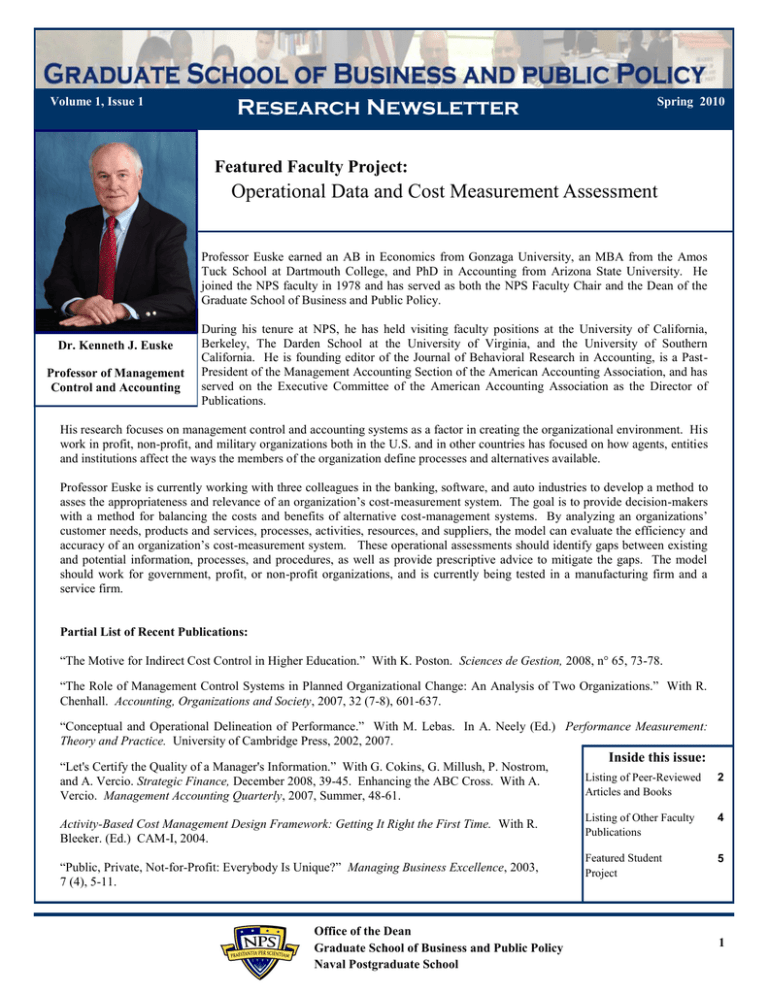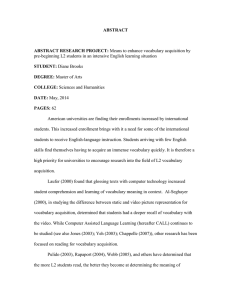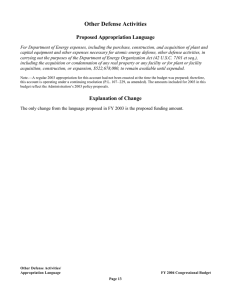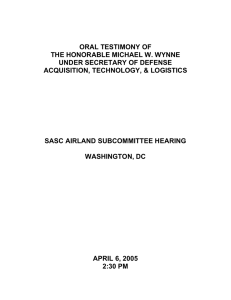Research Newsletter Operational Data and Cost Measurement Assessment Featured Faculty Project:
advertisement

Volume 1, Issue 1 Research Newsletter Spring 2010 Featured Faculty Project: Operational Data and Cost Measurement Assessment Professor Euske earned an AB in Economics from Gonzaga University, an MBA from the Amos Tuck School at Dartmouth College, and PhD in Accounting from Arizona State University. He joined the NPS faculty in 1978 and has served as both the NPS Faculty Chair and the Dean of the Graduate School of Business and Public Policy. Dr. Kenneth J. Euske Professor of Management Control and Accounting During his tenure at NPS, he has held visiting faculty positions at the University of California, Berkeley, The Darden School at the University of Virginia, and the University of Southern California. He is founding editor of the Journal of Behavioral Research in Accounting, is a PastPresident of the Management Accounting Section of the American Accounting Association, and has served on the Executive Committee of the American Accounting Association as the Director of Publications. His research focuses on management control and accounting systems as a factor in creating the organizational environment. His work in profit, non-profit, and military organizations both in the U.S. and in other countries has focused on how agents, entities and institutions affect the ways the members of the organization define processes and alternatives available. Professor Euske is currently working with three colleagues in the banking, software, and auto industries to develop a method to asses the appropriateness and relevance of an organization’s cost-measurement system. The goal is to provide decision-makers with a method for balancing the costs and benefits of alternative cost-management systems. By analyzing an organizations’ customer needs, products and services, processes, activities, resources, and suppliers, the model can evaluate the efficiency and accuracy of an organization’s cost-measurement system. These operational assessments should identify gaps between existing and potential information, processes, and procedures, as well as provide prescriptive advice to mitigate the gaps. The model should work for government, profit, or non-profit organizations, and is currently being tested in a manufacturing firm and a service firm. Partial List of Recent Publications: “The Motive for Indirect Cost Control in Higher Education.” With K. Poston. Sciences de Gestion, 2008, n° 65, 73-78. “The Role of Management Control Systems in Planned Organizational Change: An Analysis of Two Organizations.” With R. Chenhall. Accounting, Organizations and Society, 2007, 32 (7-8), 601-637. “Conceptual and Operational Delineation of Performance.” With M. Lebas. In A. Neely (Ed.) Performance Measurement: Theory and Practice. University of Cambridge Press, 2002, 2007. “Let's Certify the Quality of a Manager's Information.” With G. Cokins, G. Millush, P. Nostrom, and A. Vercio. Strategic Finance, December 2008, 39-45. Enhancing the ABC Cross. With A. Vercio. Management Accounting Quarterly, 2007, Summer, 48-61. Activity-Based Cost Management Design Framework: Getting It Right the First Time. With R. Bleeker. (Ed.) CAM-I, 2004. “Public, Private, Not-for-Profit: Everybody Is Unique?” Managing Business Excellence, 2003, 7 (4), 5-11. Office of the Dean Graduate School of Business and Public Policy Naval Postgraduate School Inside this issue: Listing of Peer-Reviewed Articles and Books 2 Listing of Other Faculty Publications 4 Featured Student Project 5 1 Volume 1, Issue 1 Research Newsletter Spring 2010 Listing of Spring 2010 Peer-Reviewed Articles and Books: Aruna Apte “HSI Practices in Program Management: Case Studies of Aegis.” The Economics of Human Systems Integration. Rouse, W. Ed. John Wiley & Sons, Hoboken, NJ. Summary: The study provides descriptive case studies that chronicle the operational and engineering processes used to reduce total ownership cost for microwave tubes and radar phase shifters, components of the AEGIS Combat System, while dramatically improving their operational availability. They capture the program management practices, especially the Integrated Product Teams, used in these processes. The processes used to achieve these results are important to understand in light of the current reductions in various acquisition support resources including financial support, manpower, and in-house technical expertise. In particular, the cases highlight the role that Naval Warfare Centers and their resident technical staff can and do play in the acquisition process and their supporting engineering disciplines. Aruna Apte, Uday Apte, and Rene Rendon “Contracting for the Services in the U.S. Army: Empirical Study of the Current Management Practices,” Journal of Contract Management. (Best Paper Award (Professional Category) in 2010 W. Gregor Macfarlan Excellence in Contract Management Research and Writing Program) Summary: This article presents the results of an empirical study of current management practices in services acquisition in the U.S. Army. The authors developed and used a web-based survey to collect primary data on the acquisition strategy, procurement methods, and contract types used at army installations. For the most part, the authors found that the services contracts awarded and administered conformed to their expectations, however, the survey respondents indicated that the number of authorized staff positions in the army for services acquisition was inadequate and that the existing billets were inadequately filled. Another surprising finding was that the project teams were often led by the contracting officer as opposed to a formally-designated project manager responsible for the overall service project success. Uday Apte, Nicholas Dew, and Geraldo Ferrer “When Is RFID Right for Your Service?” International Journal of Production Economics, 124: 414–425. Summary: Radio Frequency Identification (RFID) is a technology that is being applied increasingly to services. The authors study several different RFID applications in services to discover how this technology can be used to enhance various aspects of service delivery, and what costs and benefits arise from it. The authors use a well-known conceptual framework that has been used to explain the evolution of services to show how RFID generally impacts service operations in a variety of scenarios. Frank Barrett “Toward High Involvement Strategy Formation: Conversations and Decisions That Matter.” With S. Romme. Journal of Corporate Citizenship. Summary: A major deficiency of traditional strategy making is that most minds within the organization are not brought into the process. This paper provides a framework for understanding and designing high involvement processes for generating and implementing strategic change. The authors summarize and compare the two high involvement approaches that have been extensively tested in a variety of organizations: Appreciative Inquiry and Circular Organizing. Mark Eitelberg Review of “I Want You! The Evolution of the All-Volunteer Force.” Armed Forces & Society, 36, 571-575. Summary: This is a book review of Bernard Rostker’s I Want You! The Evolution of the All-Volunteer Force that was published by the RAND Corporation in 2006. The book describes in considerable detail one the boldest government experiments of our time, creating and maintaining a “superpower” military force without resorting to conscription. Office of the Dean Graduate School of Business and Public Policy Naval Postgraduate School 2 Volume 1, Issue 1 Research Newsletter Spring 2010 Listing of Spring 2010 Peer-Reviewed Articles and Books (continued): Deborah Gibbons “Dynamics of friendship reciprocity among professional adults.” With P. Olk. Journal of Applied Social Psychology, 40(5), 1146-1171. Summary: Friendship is generally a reciprocal relation, yet many enduring ties are not symmetrical. Sometimes, only one member of a dyad considers the other a friend, or may see their relation as a close friendship while the other does not. Existing theories imply that personal and social attributes may influence the likelihood of reciprocity in friendship. In this longitudinal study, the authors found that demographic and educational attributes had little effect, but relative gregariousness and popularity consistently influenced development and persistence of unequally reciprocated friendships in 2 cohorts of executive MBA students. Tim Hawkins “Exploring the Application of Electronic Reverse Auctions in Federal Procurement: Removing Barriers to Unleash Savings.” With A. Coyne and B. Hudgens. Air Force Journal of Logistics. Summary: This case study explores the first and only electronic reverse auction (e-RA) conducted by the United States Air Force in Kuwait and addresses gaps in application within the Department of Defense. Qualitative research based on a single case study explored procedures DoD contracting officers could follow to use e-RAs for stateside and contingency procurements. A spend analysis of FY07–08 USAF procurement transactions, extrapolated across the DoD, suggests the DoD is leaving billions of dollars on the table by not using e-RAs. Larry Jones “Performance Budgeting in the U. S. Federal Government: History, Status and Future Implications.” With J. McCaffery. Public Finance and Management, 10(3), 510-532. Summary: Performance budgets emphasize activities performed and their costs, and include various performance measures in the budget to document what is gained from what is spent. This article notes the long period of experimentation with performance budgeting in the U.S. and identifies some of the lessons learned from this initiative. It also addresses reforms including the Office of Management and Budget (OMB) Program Assessment Rating Tool (PART) as they relate to incentives for budgeting based on performance. Uday Apte, Michael Boudreau, Ken Doerr, Keebom Kang “A Decision Support Model for Valuing Proposed Improvements in Component Reliability,” Military Operations Research. Summary: The U.S. Department of Defense is engaged in a number of management initiatives (related to weapon system logistics and support) intended to provide reduced life cycle costs while simultaneously improving operational availability (Ao). Performance-based Logistics (PBL) is one such program that entails the establishment of a particular kind of contractual vendor-client relationship between a logistic-service provider and a weapon-system manager. This paper will examines how best to value the desired outcomes of a PBL contract. Developing a methodology and a tool for estimating the Ao of a weapon system based on component-level reliability and maintainability data is the goal of this research. Jim Suchan “The role of management and leadership in complex, turbulent organizational environments,” Drastamat Kanayan Institute for National Defense Strategic Studies Academic Journal, 4(62), 73-85. Summary: The roles and responsibilities of leadership and the relationship between management, leadership, and communication are often misunderstood in military and government organizations. Consequently, this article has three purposes: (1) to describe fundamental differences between management and leadership in evolving democracies, (2) to explain how management and leadership thinking must complement each other, (3) and to discuss several of the key communication competencies leaders must develop. Office of the Dean Graduate School of Business and Public Policy Naval Postgraduate School 3 Volume 1, Issue 1 Research Newsletter Spring 2010 Listing of Other Spring 2010 Faculty Publications: Apte, A., Apte, U., Rendon, R. “Services Supply Chain in the Department of Defense: Comparison and Analysis of Acquisition Management in the Army, Navy, and Air Force.” Acquisition Research Program, April 1, 2010. Apte, A., Ferrer, G. “Lifecycle Information of Aircraft Engine Maintenance.” Acquisition Research Program, April 1, 2010. Bergey, J., Jones, L. “Exploring Acquisition Strategies for Adopting a Software Product Line.” Acquisition Research Program, April 1, 2010. Dillard, J., Ford, D., Housel, T. “Integrating System Dynamics Modeling and Knowledge Value Added for Improved Analysis of Alternatives: A Proof of Concept Study.” Acquisition Research Program, April 1, 2010. Franck, R., Lewis, I., Udis, B. “Global Cooperation and Competition in the Defense and Aerospace Industries.” Acquisition Research Program, April 1, 2010. Huynh, T., Osmundson, J., Rendon, R. “Research on Systems-of-Systems Acquisition.” Acquisition Research Program, April 1, 2010. Mehay, S., Pema, E., and McLaughlin, J. “Analysis of the Tuition Assistance Program: Does the Method of Instruction Matter in TA Classes?” NPS Technical Report, April 15, 2010. Angelis, D., Benishek, P., Kidalov, M., Sheinman, B. “Better Acquisition Management Through ADR and Other Best Practices for Preventing and Resolving Bid Protests.” Acquisition Research Program, May 1, 2010. Arkes, J., Coughlan, P., Gates, B., Myung, N. “Prediction Markets for Defense Acquisition: The Devil is in the Details.” Acquisition Research Program, May 1, 2010. Bergey, J., Jones, L. “Exploring Acquisition Strategies for a Software Product Line.” Acquisition Research Program, May 1, 2010. Coughlan, P., Gates, B. “Split Awards and Bid Protests in Acquisition.” Acquisition Research Program, May 1, 2010. Dillard, J. “Panel 21: Innovations in DoD Acquisition Policy.” Acquisition Research Program, May 1, 2010. Dillard, J., Ford, D., Housel, T. “System Dynamics Modeling for Improved Knowledge Value Assessment: A Proof of Concept Study.” Acquisition Research Program, May 1, 2010. Ferrer, G. “The Remanufacturing Process of Defense Assets with Stochastic Yield.” Acquisition Research Program, May 1, 2010. Hensel, N. “The Impact of Globalization and Shifting Defense Priorities on the Defense Industrial Base.” Acquisition Research Program, May 1, 2010. Brinkley, D. “Classroom Computing Using On Demand Desktop Streaming.” NPS Technical Report, May 20, 2010. Apte, A., Apte, U., Hegde, G., Rendon, R. 17th International Annual EurOMA Conference 6-9 June 2010, Porto, Portugal. “Managing the Services Supply Chain in the U.S. Department of Defense: Empirical Study of the Current Management Practices in the Army.” Office of the Dean Graduate School of Business and Public Policy Naval Postgraduate School 4 Volume 1, Issue 1 Research Newsletter Spring 2010 Featured Student Project: Analysis of Vessels and Acquisition Methods Utilized to Support Maritime Irregular Warfare On June 8, 2010 LT Christopher Kelley, LT Justin Bummara, and MAJ Bill Clark were given the Surface Navy Association Award for Academic Excellence in a thesis that makes a significant Keenan Yoho, LT Christopher Kelley, LT Justin M. Bummara, contribution to surface warfare. This thesis was advised by MAJ William J. Clark, and RADM James B. Greene, Jr. RADM James B. Greene, Jr., USN (Ret.) and Assistant Professor Keenan D. Yoho of the GSBPP and was supported by funding from the Acquisition Research Program. The thesis was GSBPP’s contribution to the Warfare Innovation which coordinated research in maritime irregular warfare across campus and is chaired by CAPT Doug Otte and CAPT Jeff Kline, USN (Ret.) of the Graduate School of Operations and Information Sciences (GSOIS). MAJ Clark, LT Kelley, and LT Bummara worked across campus with COL Jeff Appleget, USA (Ret.) and students in his OA4604 Wargaming Applications course within the Operations Research curriculum of GSOIS to conduct a capabilities analysis of three different vessels. CAPT Wayne Hughes, USN (Ret.) of GSOIS and CDR Bill Hatch, USN (Ret.) of the GSBPP executive MBA programs were called upon for their surface warfare experience to captain vessels during the exercise and graciously donated their time and effort to the project. This thesis complements a larger study for the Commander of U.S. Special Operations Command and Navy Special Warfare Command by Dr. Paul DeLuca and Dr. Dick Hoffmann of The RAND Corporation. LT Kelley briefed the results of the thesis to both RAND and NAVSPECWARCOM in May of this year. This thesis is having an impact on current irregular warfare policy being developed by Navy Special Warfare Command and has been distributed to many senior leaders to include the Undersecretary of the Navy, the Commander of U.S. Special Operations Command, Rear Admiral Mark H. Buzby, Commander, Military Sealift Command, and the Principal Deputy and Senior Director for Future Capabilities, Office of the Deputy Under Secretary of the Navy. Abstract of the study: The U.S. Navy is at a critical juncture in determining the types and numbers of ships it will acquire, retire and sustain in order to execute A Cooperative Strategy for 21st Century Seapower which outlines how Navy, Coast Guard and Marine Corps maritime power will be used to protect vital U.S. interests over the next several decades. In addition to determining how many aircraft carriers, cruisers, amphibious assault craft, fighters, and helicopters it will need, the Navy must determine how it will confront maritime irregular warfare. This study introduces a method for evaluating the capability and costs of candidate vessels that will aid the Navy in its maritime irregular warfare policy development. Our method is novel in that it introduces a cost and capability analysis that will aid policy makers in their resource allocation decisions. About the students: LT Justin M. Bummara (SWO, United States Navy), MAJ William J. Clark (Infantry, United States Army), and LT Christopher Kelley (SEAL, United States Navy) graduated from the MBA program at the Naval Postgraduate School (NPS) in June 2010. Office of the Dean Graduate School of Business and Public Policy Naval Postgraduate School 5







